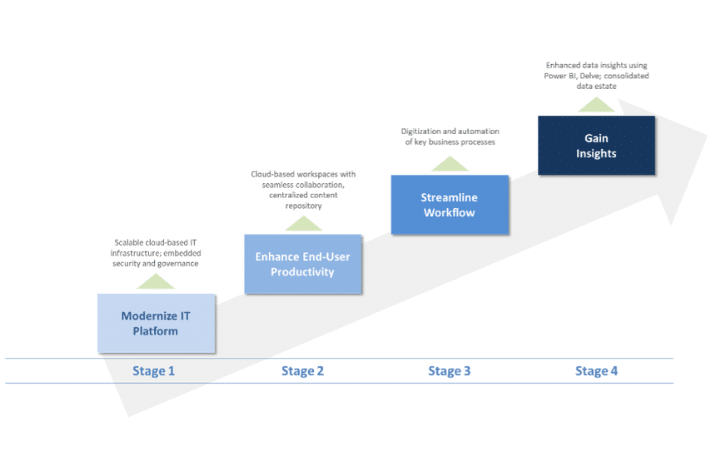1. Tech intensity is key for firms to adapt and thrive
CPA firms today are navigating several common challenges as they seek to expand their advisory services through organic growth, merger & acquisition (M&A) activity, or a combination of both. These include fostering a new hybrid work culture, overcoming staffing constraints, onboarding capacity in remote geographies, and shaping a digital-first client experience. These challenges reinforce the pressing urgency for firms to accelerate their digital transformation agenda and build their own digital capabilities and intellectual property. If there is one overarching yardstick that has become key to gauging which firms will adapt and thrive, it is tech intensity. Coined by Microsoft, tech intensity is defined as how quickly a firm adopts the latest technology and integrates it into its core processes, shaping its own unique digital capabilities that extend across both its clients and employees. Simply put, tech intensity = rate of tech adoption + current tech capability. Firms that focus on tech intensity will break out from the rest of the pack.
2. A modern cloud-enabled technology stack is a critical enabler
The firm of the future will be one that actively incorporates technology in shaping a differentiated and digitally proficient experience for its clients and employees. There are four key areas of focus that will enable their differentiation:
- Modern Technology Stack: The underlying IT infrastructure is running in a public cloud (e.g., Microsoft Azure), tapping into all the benefits that this unlocks including agility, scale, and resiliency. Most importantly, operating in a public cloud model opens a pathway to accelerated adoption of newer technologies and services, all aimed at redefining the end-client and end-user experience.
- Normalized Data Estate: Aggregating the siloed data assets across all key applications that power Tax, Accounting, Audit, and Advisory services with visualization and advanced analytics to facilitate real-time decision making and planning.
- Enhanced Technology Competency: Through an agile L&D program that relies on both internal talent dev and industry partnerships, Firms will efficiently bridge the knowledge gaps created by the quick pace of tech adoption. Strong leadership from IT, coupled with empowerment from the Managing Partners/Executive Management, is critical to the success of this transformation.
- Culture of Change: Firms steeped in embracing a culture that fosters and rewards innovation, celebrates out-of-the-box thinking, and seeks the disruptors in place of the status quo. Talent is sought for core competencies as well as innovative thinking, flexibility, and the willingness to learn and teach new things.
3. The transformation journey can be mapped across key logical phases
CPA firms have an opportunity to redefine the playing field as they modernize their tax and audit business and invest in new areas in advisory services such as strategy and operational transformation or technology and cyber services. Like any transformation, the journey to realize the “Firm of the Future Vision” needs to be pragmatic and phased, keeping in mind both the business imperatives and the current state of the internal technology infrastructure. We look at this across four distinct phases:

- Modern IT Platform: Meet employee expectations for technology and workstyles in the hybrid world, facilitating collaboration across internal and external virtualized teams. Adopting a cloud-first solution like Microsoft Azure with Azure Virtual Desktops (AVD) is critical, as it facilitates scale, security, and seamless integration with modern collaboration platforms like Teams and CPA Firm SaaS applications such as CCH Axcess Tax. This allows for a more fluid end user experience.
- Enhanced End-User Productivity: Enable employees to collaborate across teams and physical space with shifted schedules and a globally distributed workforce. The remote work experience needs to have full fidelity with in-office work, and workplace insights and performance to include all work styles. The Microsoft Teams platform unlocks these benefits, bringing tight coupling to the rest of Microsoft’s Office 365 suite and its Azure Virtual Desktop solution.
- Streamlined Workflow: Automate repetitive, manual tasks by leveraging core M365 technology infrastructure tools like Microsoft Power Automate. With limited effort, you can streamline and digitize tasks such as client and employee onboarding, extension processes, K1 distributions and countless administrative workflows.
- Insights: Acquire, access, and analyze information efficiently to increase agility in the firm’s execution while fostering a data-driven culture. Realizing this implies knitting the various sources of data across the CRM, practice management, tax applications, document management, and other SaaS-based services used to power the firm into a modern centralized data estate that enables timely insights and decision making.
Conclusion: Critical Success Factors
Embody a culture of change. A core tenant in addressing culture is encouraging risk by embracing and piloting new ideas as part of driving continuous improvement. This must be modeled at the leadership level, with the necessary incentives, goals, and organizational structure for the IT team to prioritize and allocate time for ideation and innovation. Further, to foster and sustain critical buy-in across the user base, the focus should be on identifying, realizing, communicating, and celebrating areas of opportunity and improvement.
Embrace foundational processes. Key processes within the firm (e.g., new client onboarding, sales qualification, advisory services workflow, billing/collection) must be baselined and normalized (or in Lean Six Sigma terms, leaned out) with a goal to simplify them wherever possible.
Facilitate leadership alignment. The partners in the firm need to be aligned in their thinking and actions as part of shaping a consistent culture that both understands and prioritizes innovation.
The primary catalyst for progress and disruption in the next five years is the explosive growth in data, and the emergence of powerful AI and machine learning tools that can reveal correlations and unlock insights in all that data. All of this, coupled with the redefining of traditional business workflows in a digital context with streamlined efficiency and automation will fundamentally redefine the client and end-user experience. Firms that embrace tech intensity will lead the way in redefining the profession.
